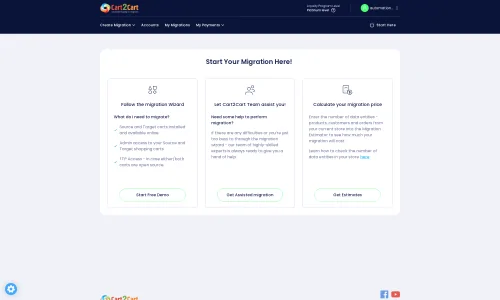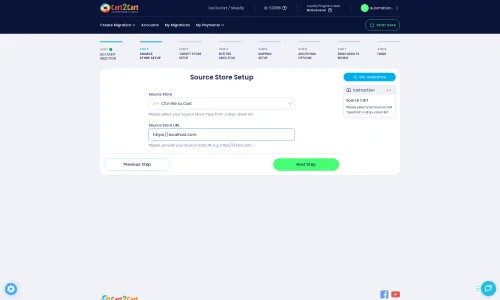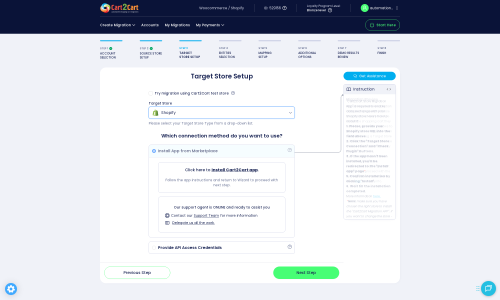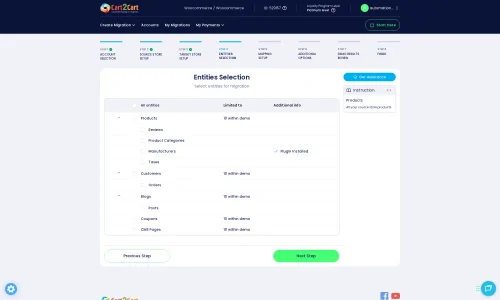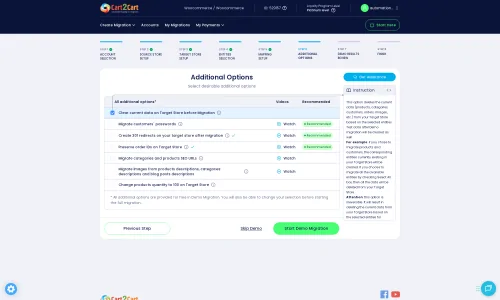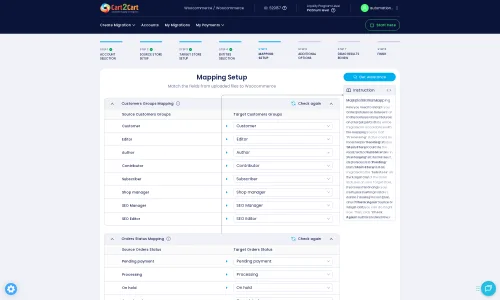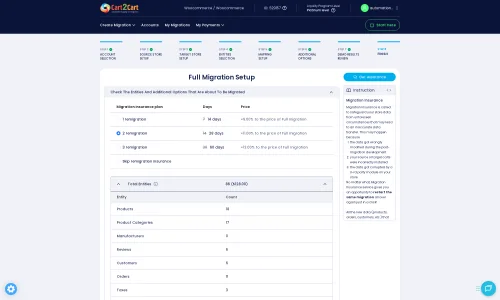GSI Commerce to Shopify Migration - Step-by-Step Guide & Expert Services
GSI Commerce to Shopify migration doesn't have to be complicated. Cart2Cart ensures a fast, secure, and SEO-preserving process with zero downtime. Ready to move GSI Commerce store to Shopify? Our automated service helps you effortlessly transfer data, maintaining all your valuable customer and product information. Whether you prefer a detailed step-by-step guide to switch from GSI Commerce to Shopify yourself or need expert assistance to manage it all for you, we deliver a seamless GSI Commerce to Shopify migration.
What data can be
migrated from GSI Commerce to Shopify
-
Products
-
Product Categories
-
Manufacturers
-
Customers
-
Orders
Estimate your Migration Cost
The price of your migration depends on the volume of data to migrate and the additional migration options you pick. To check the price for GSI Commerce to Shopify conversion, click “Get estimates” and follow the suggested steps.
How to Migrate from GSI Commerce to Shopify In 3 Steps?
Connect your Source & Target carts
Choose GSI Commerce and Shopify from the drop-down lists & provide the stores’ URLs in the corresponding fields.
Select the data to migrate & extra options
Choose the data you want to migrate to Shopify and extra options to customise your GSI Commerce to Shopify migration.
Launch your Demo/Full migration
Run a free Demo to see how the Cart2Cart service works, and when happy - launch Full migration.
Migrating from GSI Commerce to Shopify: A Comprehensive Guide
Migrating from GSI Commerce to Shopify: A Comprehensive Guide
Replatforming your e-commerce store is a significant undertaking, and moving from a legacy system like GSI Commerce to a modern, scalable platform such as Shopify can unlock immense growth potential. GSI Commerce, while once a prominent solution, often requires a more bespoke or manual approach for data extraction, typically through CSV exports, due to its older architecture.
Shopify, on the other hand, offers a robust, user-friendly, and feature-rich environment designed for contemporary online retail. This guide provides a detailed, step-by-step roadmap to successfully transition your valuable store data, including products, customer records, and order history, from GSI Commerce (via CSV files) to Shopify, ensuring a smooth data transfer and minimal downtime.
Prerequisites for Migration
Before you embark on your migration journey, proper preparation is key to ensuring data integrity and a seamless transition.
For Your GSI Commerce (Source) Store:
- Data Export: Since GSI Commerce is not directly supported by automated migration tools, you will need to export all your vital store data into CSV files. This includes:Products: SKUs, product names, descriptions, images, variants, pricing, inventory levels.
Categories: Hierarchical structure and associated products.
Customers: Customer names, email addresses, billing/shipping information.
Orders: Order IDs, order statuses, customer associations, purchased items, order totals.
Reviews: Product reviews and ratings.
CMS Pages & Blog Posts: Content, metadata.
Coupons: Codes, discounts, usage limits. - Data Cleanup: Review your exported CSV files for any outdated, redundant, or incorrect data. Cleaning your data now will prevent issues on your new Shopify store.
- Backup: Always create a full backup of your GSI Commerce store and all exported data before initiating any migration process.
For more details on preparing your source store, you can refer to our How to prepare Source store for migration? FAQ.
For Your Shopify (Target) Store:
- Set Up Your Shopify Store: Create a new Shopify account and choose a suitable plan (e.g., Basic Shopify, Advanced Shopify, Shopify Plus). Be aware that Shopify's 'Pause and Build' plan blocks orders, so plan your go-live strategy carefully.
- Install Cart2Cart App: Shopify requires the Cart2Cart Store Migration App for seamless integration. You can find this in the Shopify App Store.
- Disable Notifications: It's highly recommended to disable all store notifications on your Shopify target store during the migration process to avoid overwhelming customers or internal teams with test emails.
- Prepare for SEO: While the migration tool can handle 301 redirects, it's wise to have a plan for preserving SEO rankings and link equity by documenting your old URLs and planning for redirects, especially for core product and category pages.
- Theme and Apps: Consider your desired Shopify theme and any essential apps (like AirReviews for migrating product reviews, as Shopify requires an app for this functionality) you'll need post-migration.
For additional guidance on target store preparation, visit our How to prepare Target store for migration? FAQ.
Performing the Migration: A Step-by-Step Guide
This guide will walk you through the process using a migration wizard, which supports CSV file imports for your GSI Commerce data and connects directly to Shopify.
Step 1: Start Your Migration
Begin by accessing the migration wizard. This initial screen will prompt you to start the do-it-yourself migration process. You'll typically be offered options to start immediately, request expert assistance, or estimate costs. Choose to start the self-service migration.
Step 2: Set Up Your Source Store (GSI Commerce via CSV)
In this crucial step, you will specify your source platform. Since GSI Commerce data is handled via CSV, select "CSV File to Cart" as your source cart type from the dropdown menu. You will then upload the meticulously prepared CSV files containing your GSI Commerce data (products, customers, orders, etc.) to the migration wizard. This method is specifically designed for stores that require a file-based data transfer.
For more information on handling CSV files, please see our CSV.File Data Migration service.
Step 3: Connect Your Target Store (Shopify)
Now, select "Shopify" as your target e-commerce platform. The recommended and most straightforward connection method is to "Install App from Marketplace". Click the provided link to navigate to the Shopify App Store, install the Cart2Cart Store Migration App, and then return to the wizard. Alternatively, you can opt to "Provide API Access Credentials," which involves creating a custom app in your Shopify admin, configuring necessary API scopes, and obtaining an Admin API access token.
Step 4: Select Data Entities for Migration
This step allows you to choose exactly which types of data you wish to transfer from your GSI Commerce CSV files to Shopify. Supported entities for this migration include:
- Products (including variants, images, descriptions)
- Product Categories
- Product Reviews (requires a compatible app on Shopify, such as AirReviews)
- Customers (including their associated data)
- Orders (including order statuses and purchased items)
- CMS Pages
- Blogs and Blog Posts
- Coupons
You can select "All entities" for a comprehensive transfer or pick and choose specific data types based on your replatforming strategy.
Step 5: Configure Additional Migration Options
Tailor your migration with various advanced settings. These options help you fine-tune the data transfer and preserve critical aspects of your store. Highly recommended options include:
- Clear Target Store Data: Useful for ensuring a clean slate on Shopify, removing any demo data before the full migration. (Learn more)
- Preserve Order IDs, Customer IDs, Product IDs: Maintains the original identifiers from GSI Commerce, crucial for historical data and integrations. (How Preserve IDs options can be used?)
- Migrate Images in Description: Ensures all embedded product images or images within CMS pages are transferred.
- SEO URLs and Create 301 SEO URLs: Essential for maintaining your search engine rankings and link equity by automatically creating redirects from your old GSI Commerce URLs to the new Shopify ones.
- Migrate All Categories: Ensures your entire product categorization structure is moved.
- Migrate Groups to Tags: Converts customer groups from GSI Commerce into customer tags in Shopify for better segmentation.
- Concat Short Description: Combines short and long descriptions if desired for Shopify's structure.
Step 6: Data Mapping
In this step, you will match specific data fields from your GSI Commerce CSV files to their corresponding fields in Shopify. This is particularly important for customer groups and order statuses to ensure consistency in roles and workflows on your new platform. For example, you'll map "Pending" in GSI Commerce to "Pending Payment" in Shopify.
Step 7: Perform a Free Demo Migration (Highly Recommended)
Before committing to the full migration, run a free demo migration. This transfers a limited number of entities (e.g., 10 products, 10 customers, 10 orders) to your Shopify store. It's an invaluable opportunity to:
- Test the connection and data flow.
- Verify data integrity and accuracy on your Shopify store.
- Identify any potential issues or adjustments needed before the full transfer.
- Familiarize yourself with the process.
Step 8: Launch Full Migration
Once you are satisfied with the demo results and all settings are configured, proceed with the full migration. Review the summary of items to be transferred and the total cost. You may also consider adding a Migration Insurance Service, which allows for multiple remigrations within a set period, offering peace of mind. (How Migration Insurance works?)
Initiate the full data transfer. The migration wizard will handle the heavy lifting, ensuring your data is moved efficiently and with minimal impact on your current GSI Commerce operations.
Post-Migration Steps
The data transfer is a major milestone, but your work isn't quite finished. These post-migration steps are crucial for a successful launch of your new Shopify store.
- Thorough Data Verification: Once the migration is complete, meticulously check your Shopify store.
- Products: Ensure all SKUs, descriptions, images, pricing, variants, and inventory levels are accurate.
- Customers: Verify customer accounts and their associated order histories.
- Orders: Confirm that all orders, including their statuses, have transferred correctly.
- Content: Review CMS pages, blog posts, and any other static content.
- Reviews: Check if product reviews (via the AirReviews app or similar) are correctly displayed.
- Configure Store Settings:
- Payment Gateways: Set up your preferred payment processors (e.g., Shopify Payments, PayPal, Stripe).
- Shipping: Define your shipping zones, rates, and carriers.
- Taxes: Configure your tax settings, noting that Shopify allows for multi-tax structures.
- Theme Customization: Brand your Shopify store to match your aesthetic and ensure a consistent user experience.
- App Installation: Install and configure any additional Shopify apps essential for your business operations (e.g., marketing, customer service, analytics).
- SEO and Redirects:
- Verify 301 Redirects: If you opted for 301 redirects during migration, test them to ensure old GSI Commerce URLs correctly point to their new Shopify counterparts. This is vital for maintaining your SEO rankings and link equity.
- Update Google Search Console: Inform Google of your site's change of address.
- Monitor SEO Performance: Keep a close eye on your search engine rankings and organic traffic in the weeks following the launch.
- Testing and Quality Assurance:
- Checkout Process: Perform test purchases to ensure the entire checkout flow, from adding to cart to payment confirmation, works flawlessly.
- Mobile Responsiveness: Check your store's appearance and functionality across various devices and browsers.
- Integrations: Test any third-party integrations (e.g., ERP, CRM, email marketing) you've set up with Shopify.
- Go Live and Monitor: Once you're confident everything is in order, officially launch your Shopify store! Continuously monitor performance, user feedback, and sales data to address any post-launch issues promptly.
By following these steps, your replatforming journey from GSI Commerce to Shopify will be well-managed, efficient, and set your business up for future success on a powerful e-commerce platform.
Ways to perform migration from GSI Commerce to Shopify
Automated migration
Just set up the migration and choose the entities to move – the service will do the rest.
Try It Free
Data Migration Service Package
Delegate the job to the highly-skilled migration experts and get the job done.
Choose Package

Benefits for Store Owners

Benefits for Ecommerce Agencies
Choose all the extra migration options and get 40% off their total Price

The design and store functionality transfer is impossible due to GSI Commerce to Shopify limitations. However, you can recreate it with the help of a 3rd-party developer.
Your data is safely locked with Cart2Cart
We built in many security measures so you can safely migrate from GSI Commerce to Shopify. Check out our Security Policy
Server Security
All migrations are performed on a secure dedicated Hetzner server with restricted physical access.Application Security
HTTPS protocol and 128-bit SSL encryption are used to protect the data being exchanged.Network Security
The most up-to-date network architecture schema, firewall and access restrictions protect our system from electronic attacks.Data Access Control
Employee access to customer migration data is restricted, logged and audited.Frequently Asked Questions
How long does a typical GSI Commerce to Shopify migration take?
How can I prevent SEO ranking loss when migrating from GSI Commerce to Shopify?
Will my existing GSI Commerce store design transfer directly to Shopify?
Is my data secure during the GSI Commerce to Shopify migration?
What factors influence the cost of a GSI Commerce to Shopify migration?
What data entities are migrated from GSI Commerce to Shopify?
How is data accuracy ensured after migrating from GSI Commerce to Shopify?
Can customer passwords be migrated from GSI Commerce to Shopify?
Will my GSI Commerce store experience downtime during migration to Shopify?
Should I use an automated tool or hire an expert for GSI Commerce to Shopify migration?
Why 150.000+ customers all over the globe have chosen Cart2Cart?
100% non-techie friendly
Cart2Cart is recommended by Shopify, WooCommerce, Wix, OpenCart, PrestaShop and other top ecommerce platforms.
Keep selling while migrating
The process of data transfer has no effect on the migrated store. At all.
24/7 live support
Get every bit of help right when you need it. Our live chat experts will eagerly guide you through the entire migration process.
Lightning fast migration
Just a few hours - and all your store data is moved to its new home.
Open to the customers’ needs
We’re ready to help import data from database dump, csv. file, a rare shopping cart etc.
Recommended by industry leaders
Cart2Cart is recommended by Shopify, WooCommerce, Wix, OpenCart, PrestaShop and other top ecommerce platforms.



